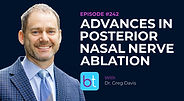BackTable / ENT / Podcast / Episode #77
In-Office Procedures for Chronic Rhinitis
with Dr. Stan McClurg
In this episode, Dr. Stan McClurg, a private practice rhinologist at Ascentist Healthcare in Kansas City, shares his approach to diagnosis and treatment of chronic rhinitis patients using the in-office RhinAer procedure.
This podcast is supported by:
Be part of the conversation. Put your sponsored messaging on this episode. Learn how.

BackTable, LLC (Producer). (2022, November 15). Ep. 77 – In-Office Procedures for Chronic Rhinitis [Audio podcast]. Retrieved from https://www.backtable.com
Stay Up To Date
Follow:
Subscribe:
Sign Up:
Podcast Contributors
Synopsis
First, Dr. McClurg talks us through his patient base. When he initially started as a rhinologist, he would get referrals for patients with persistent rhinitis after a procedure. Before in-office procedures for chronic rhinitis were developed, he recommended ipratropium bromide spray to patients and referred them for allergy testing. However, his recent patient referrals have been for isolated chronic rhinitis (defined by consistent rhinorrhea for more than 4 weeks) with no other ENT problems. With these patients, he performs allergy skin testing to make sure the diagnosis is not really allergic rhinitis that can be treated with desensitization therapy. He also uses a rigid nasal endoscope to check the patient’s nose for colored purulence and polyps, two clues that can point to a diagnosis other than chronic rhinitis. When he scopes his patient, he does not use a decongestant spray and uses a small endoscope to avoid patient discomfort. If he believes that a patient has chronic rhinitis, he will perform a ipratropium bromide challenge; he asks patients to use the spray for 1 month. If their symptoms are mitigated by the spray, then he is more optimistic that an in-office procedure will mitigate the chronic rhinitis. If the patient fails the trial, the secretions are probably coming from a source other than the nose, and the diagnosis is unlikely to be chronic rhinitis.
Next, Dr. McClurg speaks about different in-office treatments for chronic rhinitis. He first explains his experience with ClariFix, a procedure that uses cryoablation to freeze the posterior nasal nerve. He has found that 40% of his patients experience the known side effect of post-treatment headache. Additionally, some of them may have crusting in the sphenopalatine region that causes post-nasal drip. Since then, he has switched to using the RhinAer system, which delivers radioablation through a stylus to treat the posterior nasal nerve more aggressively. It also has the capability of treating the inferior turbinate. Dr. McClurg notes that patients with normal nasal anatomy and a good ipratropium bromide response are the best candidates for this procedure. 80% of his patients see a favorable result after surgery.
He then describes his RhinAer in-office procedure. He does these procedures in exam rooms in order to help with flow of his day and make his patients more comfortable. He only uses lidocaine to anesthetize the patient, as he has found that epinephrine causes tachycardia and anxiety. The procedure, including anesthesia time, takes him about 10 minutes. However, he adds that he has performed this procedure in the OR as an adjunct procedure after a septoplasty or a rhinoplasty.
Finally, he describes his recommendations for postoperative care. He encourages his patients to do daily saline rinses. He notes it takes about 6-8 weeks for the RhinAer procedure to show a good response. During this time, he recommends that patients use ipratropium bromide concurrently in order to obtain an optimal response.
Transcript Preview
[Stan McClurg MD]
Postnasal drip is a tough one, but I think the scope is key. When you do the rigid nasal endoscopy, initially, I use a 3-millimeter or 30-degree endoscope, and you can see pretty much everywhere up there. You're looking for any purulence, polyps, or anything like that. Sometimes you can see, clear rhinorrhea or other findings that could help you make the diagnosis. Quite honestly, most patients that have chronic rhinitis only, they'll tell you that they don't get sinus infections. It's just a constant runny nose that never goes away and it never fluctuates.
They never get facial pressure or pain, and colored drainage, I think is one of the highlights is, when people say, "I have postnasal drip." I always ask them, what color is it? A lot of people will laugh and say, "I never look at it." Then I say, "Well, you should consider looking at your snot every once in a while."
The people that have chronic rhinitis, they'll say, "It's always clear whether it's thick or thin, or other, but it never has purulent yellow-green color to it.”
The Materials available on BackTable are for informational and educational purposes only and are not a substitute for the professional judgment of a healthcare professional in diagnosing and treating patients. The opinions expressed by participants of the BackTable Podcast belong solely to the participants, and do not necessarily reflect the views of BackTable.















